All products featured are independently chosen by us. However, SoundGuys may receive a commission on orders placed through its retail links. See our ethics statement.
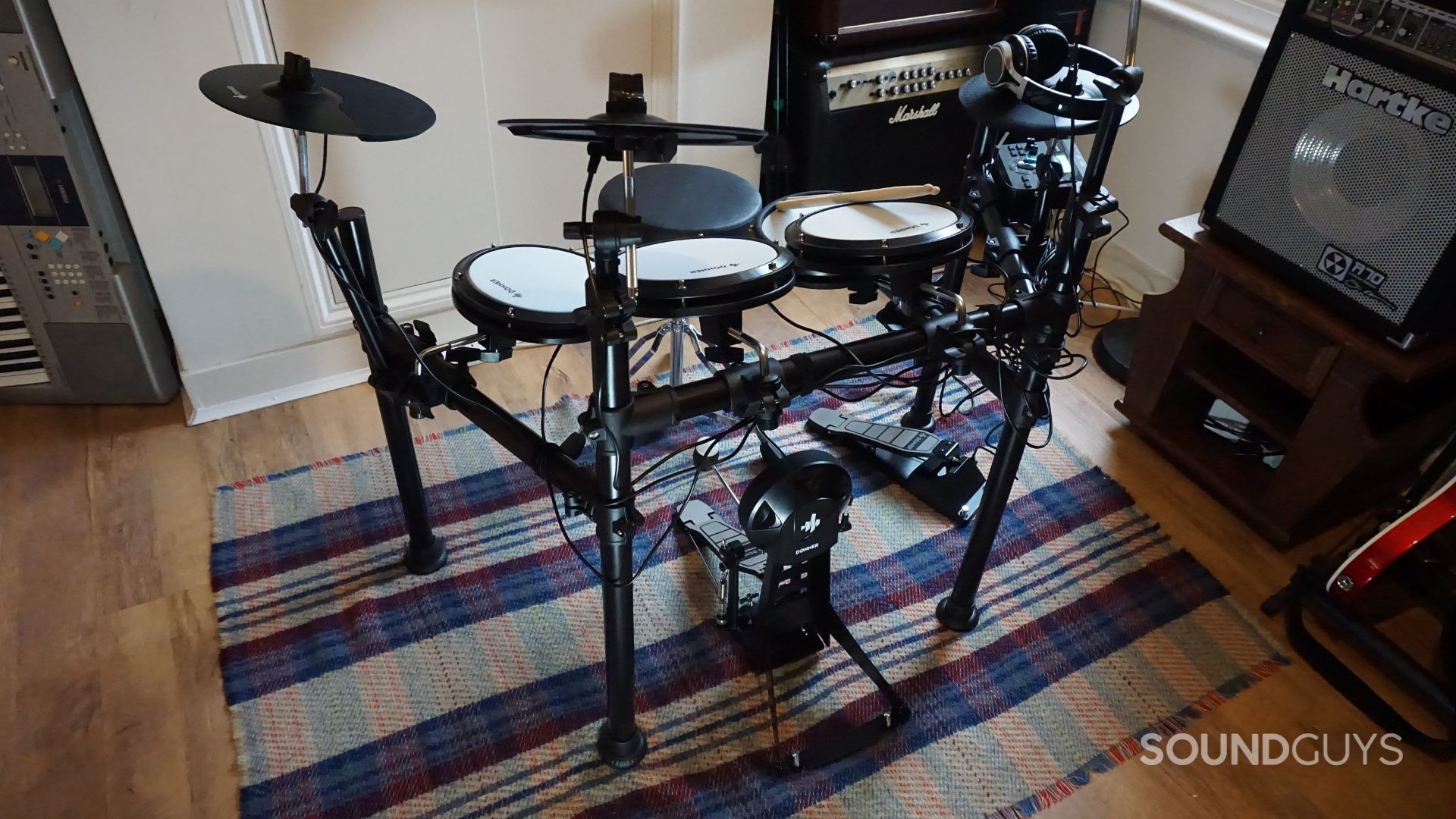
Donner DED-200 review
Published onNovember 25, 2023
Donner DED-200
Weight:
Global instrument manufacturer Donner bolsters its drum kit line with the DED-200, an affordable and versatile electronic drum kit that rests squarely in the middle of the company’s lineup. But do drummers sacrifice handy features at the expense of a wallet-friendly price tag? Discover more in our Donner DED-2oo review.
Donner DED-200 review: At a glance
- What is it? An entry-level five-pad, three-cymbal electronic drum kit model featuring 450 drum voices, 31 drum kit presets, and 50 practice songs.
- What is the price? For $499.99, you receive a feature-rich mesh-head kit.
- Where can you buy it? The Donner DED-200 is readily available worldwide through Donner's website, Amazon, and other retailers.
- How did we test it? I tried the kit for seven days. SoundGuys purchased the review unit.
- Is it worth it? While more advanced drummers will likely want a broader list of features, the Donner DED-200 is a good pick for beginners and those who want everything included in the box. It's a good practice kit and also allows advanced functionality with its USB MIDI output.
What I like about the Donner DED-200
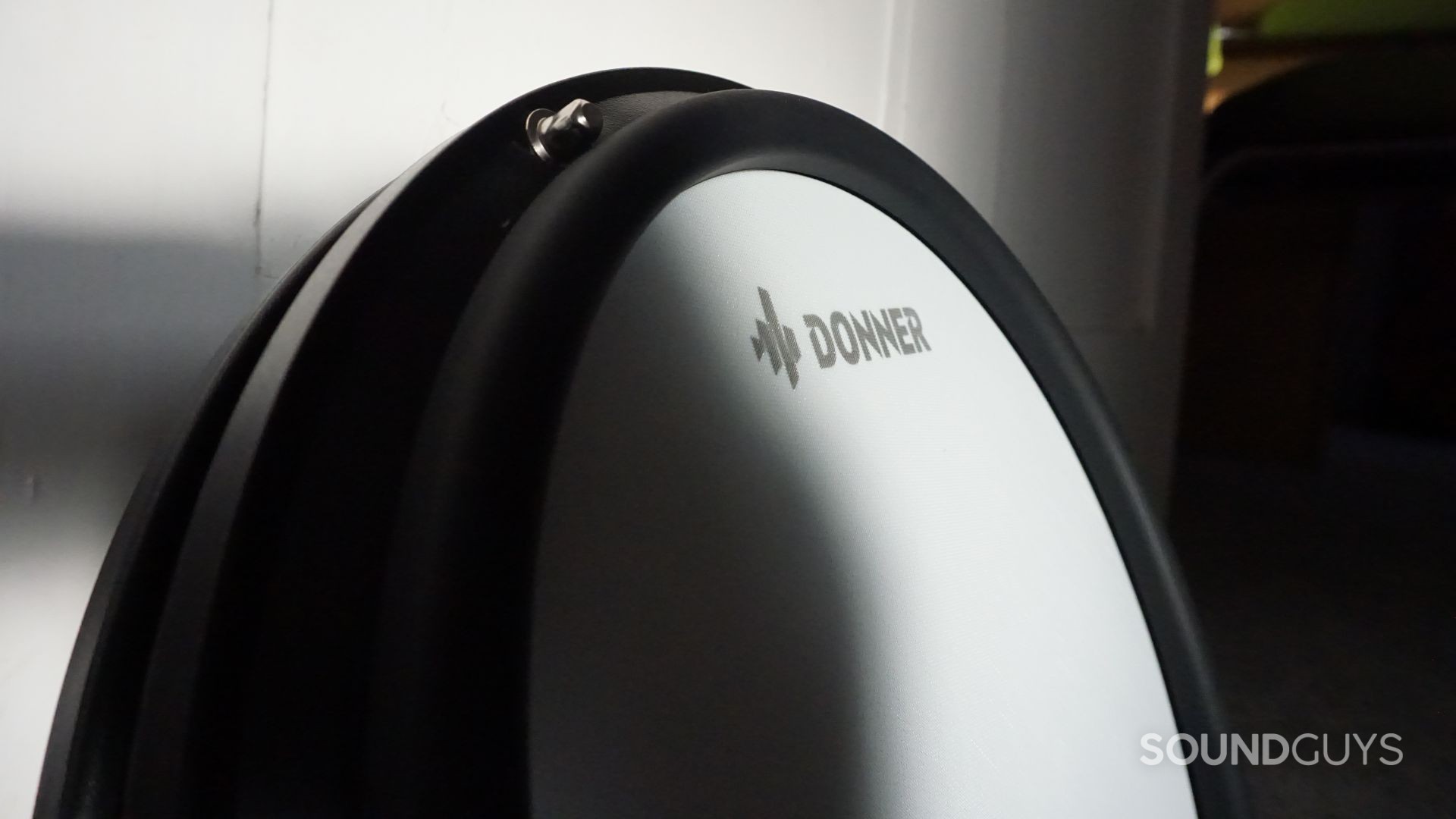
If you want an affordable electric drum kit that includes everything you need out of the box, then the Donner DED-200 fits the bill. Unlike many competitors, the package includes a drum throne, single bass pedal, wired on-ear headphones, drumsticks, and a 2m jack cable for mono output. Although the instruction manual is not always clear, assembly is straightforward. All in all, it took me a little more than 30 minutes to put it together. The included L-rods and rotating mounts made it easy to position the pads where I wanted them. Five velcro straps are included for securing the loose cables to the four-post rack. The drum kit can also be connected to an external speaker system, any wired headphones, or a USB MIDI device such as a sound card or audio interface. When recording with the latter, you can map the MIDI outputs for each pad straight from the module’s settings menu.
For the price, the Donner DED-200 plays nicely. For example, the nylon heads on the snare and toms offer a more natural response than rubber pads. The surrounding lugs can also be adjusted with the drum key to increase or decrease the tension to your preference. The 6.5-inch rubber bass tower responds well to the felt beater and is large enough to attach a double bass pedal if desired. The cymbal edges can be squeezed to recreate cymbal chokes, and the cymbal tops produce a crisper, more pronounced sound than the edges when hit. The hi-hat control pedal works well to differentiate clearly between closed, tap, and open sounds. The dual-zone snare pad features a rim sensor that can be struck to play cross-stick samples. Like the rest of the drum kit, the snare rim boasts sensitivity and velocity parameters to reproduce a more natural sound.
The Donner DED-200 boasts 31 drum kit presets, 50 playable songs, and 450 drum voices for a fraction of the price of the competition.
You can choose from 31 different drum kit presets, though the default “Pop” and “Standard” kits are the most realistic sounding. Nevertheless, you can create a custom setup under the “User” preset if you want to hone your sound. While there is only space to save one unique kit, you can pick between 30 drum voices to apply to each pad. Once selected, the module provides a list of in-depth settings and adjustments such as pad volume, sensitivity, pan, pitch, velocity, threshold, “XTalk threshold,” and repeat triggers. I found the sensitivity and threshold parameters to be handy assets. Adjusting the former influences how loud the pad sounds based on how hard you strike. The latter dictates how hard or soft you must play for the pad to register your hit.
The module also offers bass and treble dials for tuning the overall EQ of the kit. The default setting at 12 o’clock is good when using the headphones provided, but I needed to adjust them when connecting to my amplifier. There is also a master volume dial and an “Ambience” dial for applying reverb to the whole kit. The module supports three coaching lessons: Time Check, Quiet Count, and Auto U/D. Time Check is handy for practicing timekeeping, while Quiet Count measures your ability to hold time without a metronome. The Auto U/D feature gradually increases and decreases the tempo. The parameters for these lessons can be adjusted in the settings menu.
What I don’t like about the Donner DED-200
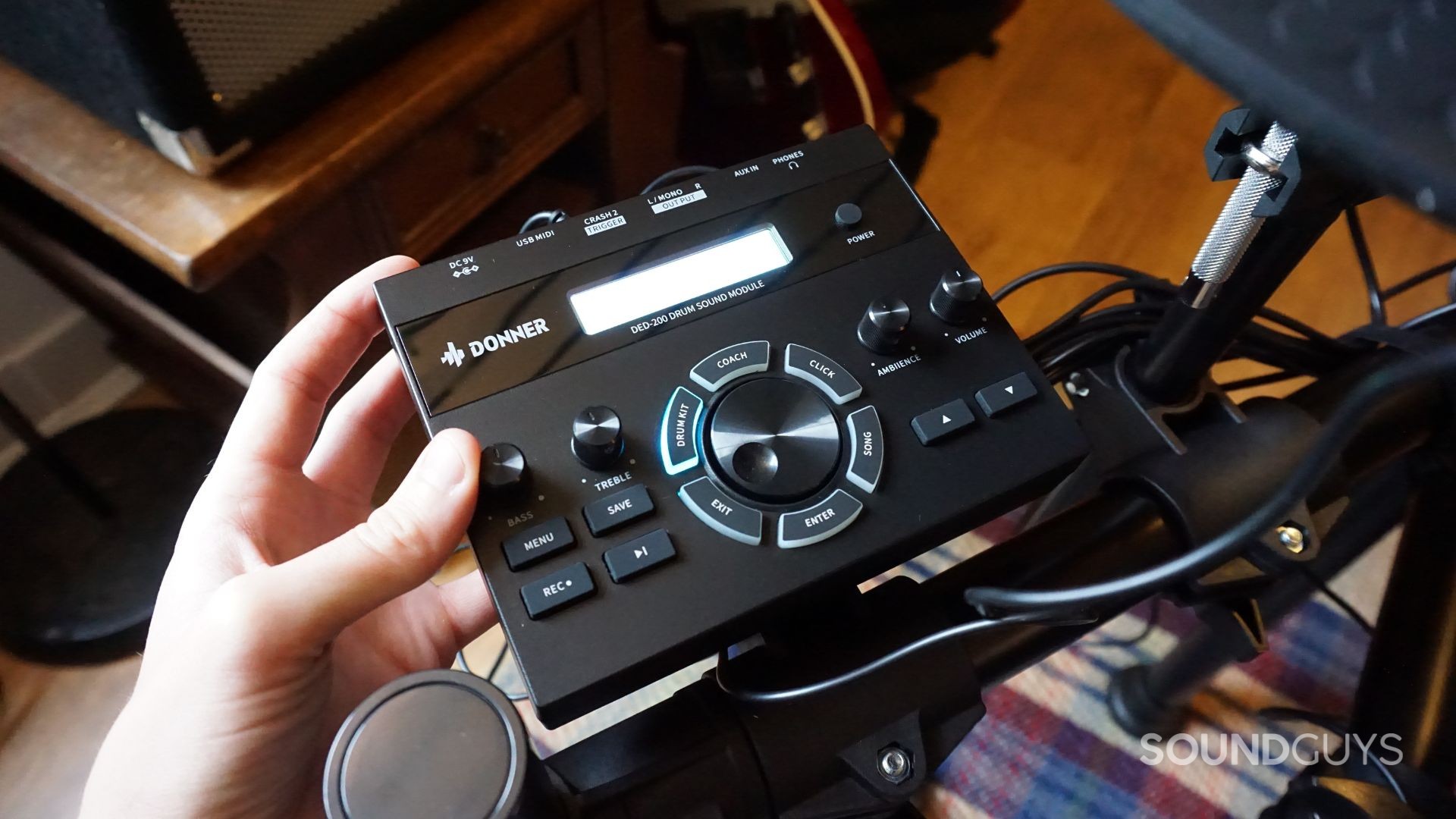
My main complaint about the Donner DED-200 is the user experience provided by the module. For example, there is no capacity for renaming the drum kit presets, including the single “User” kit. Additionally, the 50 playable songs have no titles built into the module. Instead of appearing on the LED screen, I had to refer to the instruction manual to find a list of their relevant genres. Moreover, the metronome is not integrated with the songs. While they technically run the same tempo, the strong beat one click will not necessarily match beat one of the bar. This is frustrating, as those wanting to practice their timekeeping and improvisation skills simultaneously will struggle without these two features working harmoniously.
Operating the module also took some getting used to. For example, the menu button seems to function as the enter button, while the enter button does very little. The coaching lessons are handy but only worked accurately when playing on a single pad. This could be used for practicing rudiments but struggles to register drum grooves well. You can toggle the guide drums on and off when playing back the songs, but there is no dedicated option for activating a metronome. It is also impossible to cross-consign specific pad sounds to other pads. For example, you cannot apply a ride cymbal sample to the second crash. Instead, you have to swap the pads’ jack cables and assign your chosen sample.
The practical implications of the adjustable pad parameters are hit-and-miss. While adjusting the pitch of each pad would be great for recording the drums in a particular key, there is no clear measure for what note you are pitching the drums to. Applying panning to each pad can also help make the drums sound better in your mix. However, it is confusing that central panning is set to number 64, while hard-left is zero and hard-right is 127. During testing, I also found that adjusting the velocity made little noticeable difference to the audio signal. The repeat trigger adjustment also made a very marginal difference to the output. Donner also added an “XTalk threshold” feature. I had no cross-over issues after setup, but this can be used to stop other sensors from picking up vibrations when striking other nearby pads.
The default threshold setting for the hi-hat pad makes it difficult to register fast strokes.
The module’s “ambience” dial applies reverb to the master output. Unfortunately, there are only five synthetic-sounding presets to choose between. There is also no way to assign the reverb effect to a single pad, such as the snare drum. This is because the module does not allow individually attributed effects channels. This may be due to a memory limitation, given the module’s recording button can only store your most recent take. There is no menu for storing and naming multiple recordings, and you cannot record a drum take played to the metronome or one of the built-in songs. The bass and treble dials are useful, but there is no way to see what frequencies you are adjusting or by what amount. There is also no dial for adjusting the playback volume of external media connected via the aux input, and the mono output does not automatically mute when you plug in headphones.
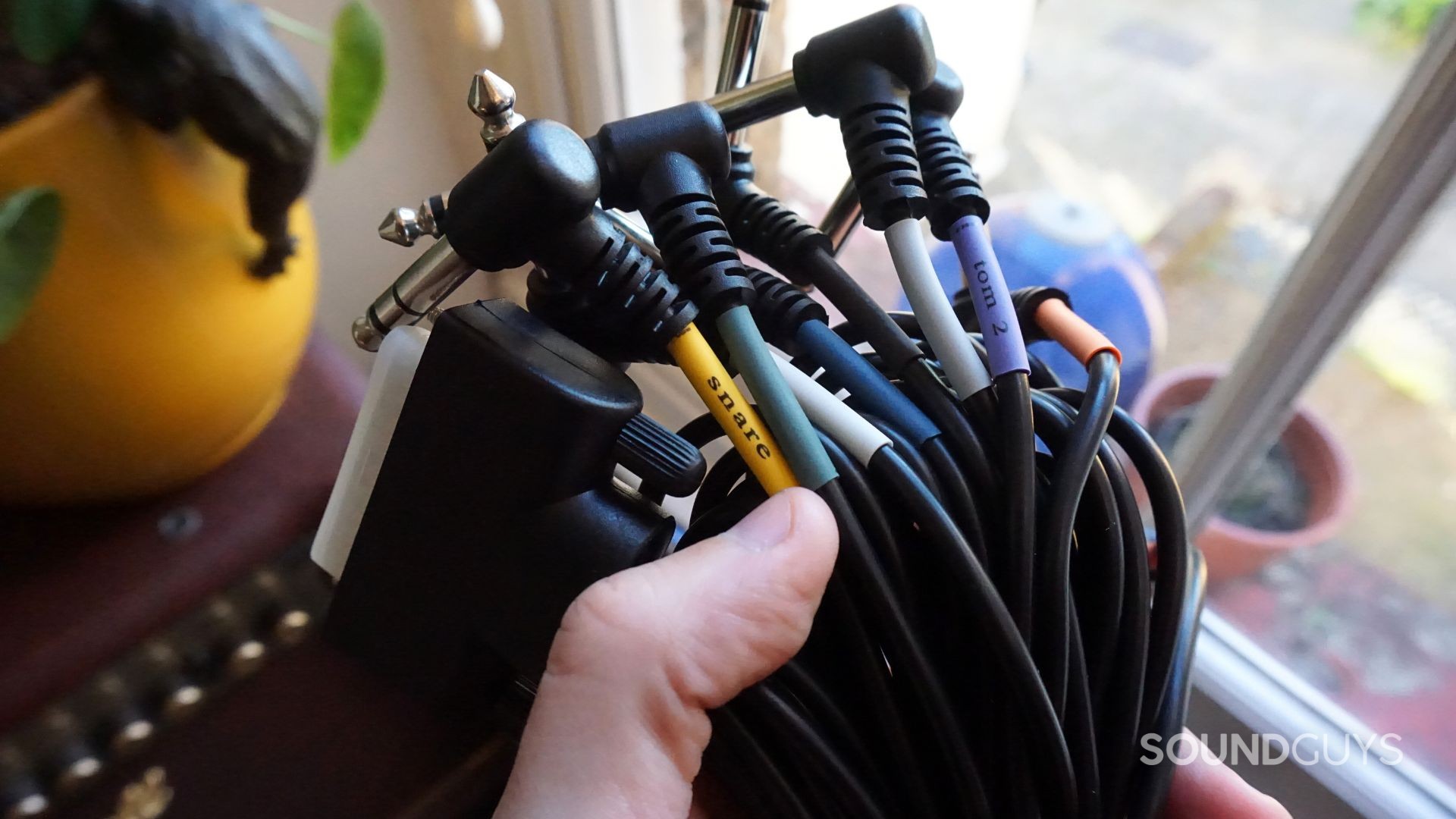
The on-ear headphones are welcome but can cause ear fatigue when used over long periods. The headband is tight, the padding is firm, and the ear cups have little maneuverability. Their 1.2m cable length is short compared to other wired headphones on the market, such as the Roland RH-5. This is also true for the power supply, which has a cable length of just 1.5m. Having so little cable length makes it difficult to position the drum kit if you do not have access to an extension cord.
Finally, the drumsticks provided are usable but are considerably lighter than their branded rivals. For example, a pair of Vic Firth 5A’s weigh 48g each. By comparison, the similarly sized Donner sticks weigh just 41g each. The wood also feels cheap and lacks any form of lacquer to protect it from sweat.
How does the Donner DED-200 sound?
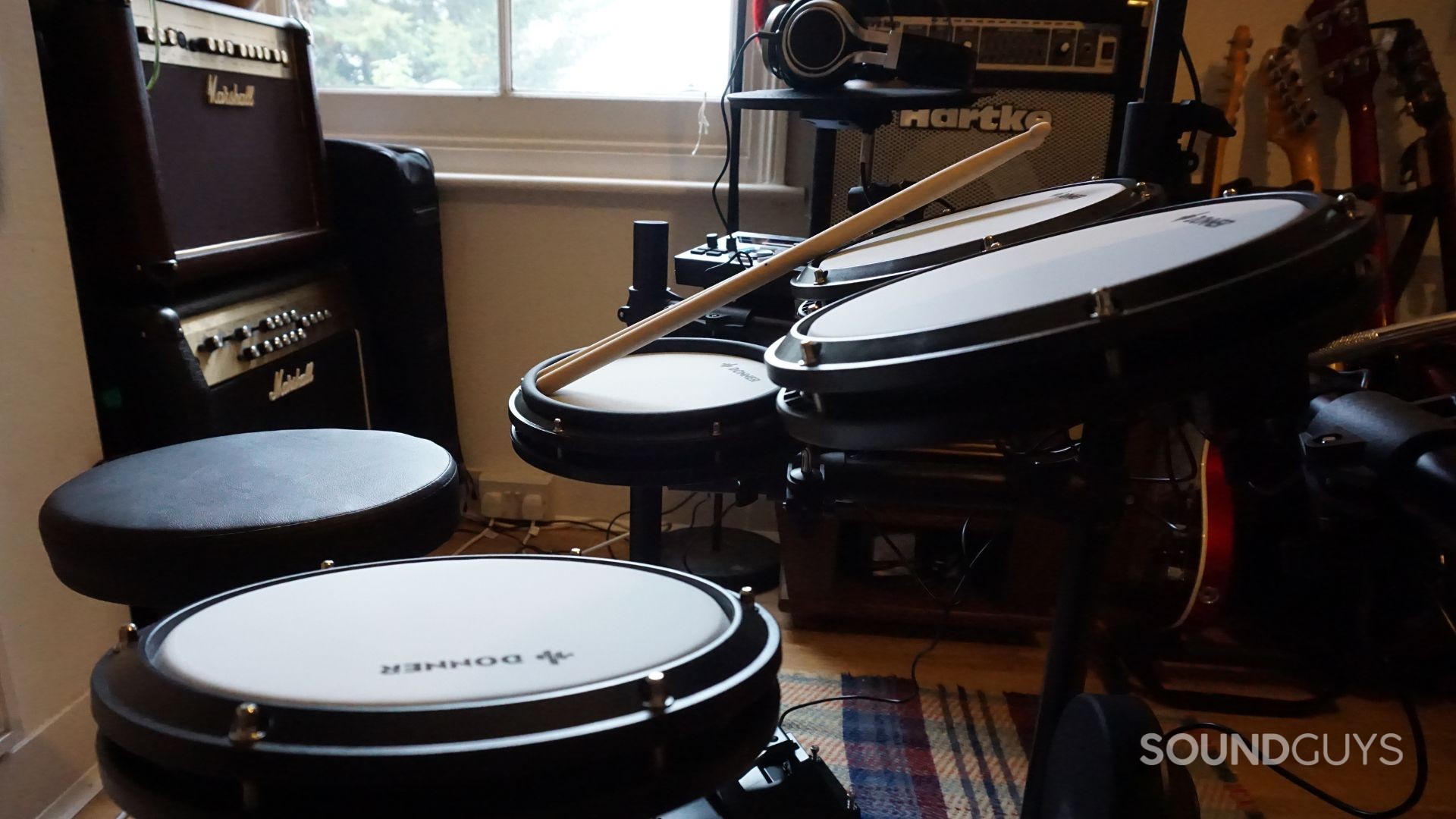
The Donner DED-200 boasts good-sounding audio for the price tag. Like almost all electronic drum kits, the DED-200 does not sound like an acoustic kit. However, most beginners will find the broad list of available pre-saved kits pleasing and fun to use. Each of the DED-200’s built-in kits is aptly named after the genres they are modeled on. For example, the Funk kit adorns a crisp-sounding hi-hat, while the Metal kit features a china cymbal. Generally speaking, the cymbals all decay nicely.
Below are three recordings of the same groove played using the Pop, Standard, and Funk drum kit presets. I recorded each sample in stereo using the two 1/4-inch (6.35mm) outputs on the back panel of the module.
Donner DED-200 Pop drum kit sample
Donner DED-200 Standard drum kit sample
Donner DED-200 Funk drum kit sample
To showcase the DED-200’s panning feature, I altered the panning parameters of every pad except the bass drum: specifically, I panned the snare drum to 80, the hi-hat to 96, the high-tom to 78, the mid-tom 32, the floor tom to 20, crash one to 115, the ride to 20, and crash two to 10.
Donner DED-200 specs
| Donner DED-200 | |
|---|---|
Size | 90.5 x 50 x 31 cm |
Weight | 25kg |
Connection | Wired |
Controls | Dials and buttons |
Audio inputs | 3.5mm AUX |
Audio outputs | 6.35mm mono 6.35mm stereo 3.5mm phones USB MIDI |
Wireless audio connection | N/A |
Connector | DC9V |
Price | $499.99 |
Should you buy the Donner DED-200?
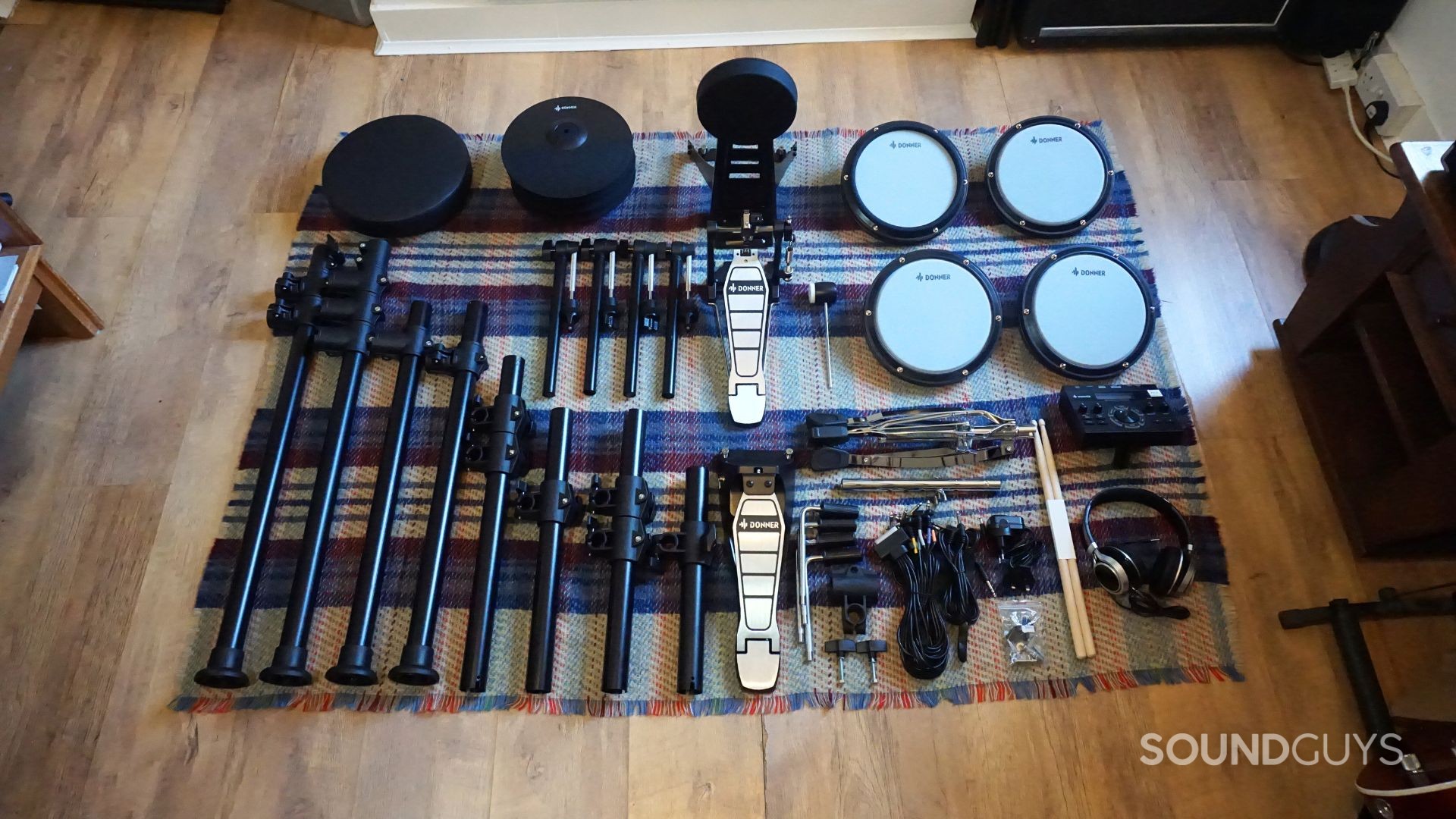
The Donner DED-200 plays nicely and has enough built-in features for most beginners. The dual-zone snare adds extra possibilities for playing cross-stick grooves, and the bass pedal and hi-hat control respond well. However, the lack of greater customization and module controls leaves much to be desired. For example, the Alesis Nitro Mesh costs under $400 and offers 20 customizable user kits, 60 play-along tracks with metronome, hi-hat splash sensitivity settings, MIDI in/out, two trigger inputs for additional cymbal and tom, and 60 free lessons from Melodics.
Nevertheless, the DED-200 is a good companion for getting to grips with the fundamentals of drumming and recording. The on-board lessons can help improve timekeeping, and the preset kits provide access to a list of fun drum voices. The USB MIDI output makes it easy to play virtual instruments in real time and to record velocity-sensitive drums into your DAW. While there is no dial for controlling the aux input volume, it is good that you can play along to your favorite songs.
For beginners or those looking for an affordable and compact studio companion, the Donner DED-200 hits the mark.
Like most lower-end electric kits, the DED-200 does suffer from the machine-gunning effect (caused by identical sounding drum samples when played in rapid succession). If you want an e-kit that offers more realistic sound quality without breaking the bank, then the Roland TD-02KV ($599.99 at Amazon) may be better. For $599, the TD-02KV provides 16 decent-sounding kits, a comprehensive built-in metronome, coaching lessons, and the ability to add wireless audio/MIDI streaming with the BOSS Bluetooth Audio MIDI Dual Adaptor.

If you want an electronic drum kit with an extensive instrument library, broad dynamic range, and greater customization, you may have to fork out more cash on a higher-end drum kit. The Donner DED-200’s strength lies in providing all the accessories you need out of the box. Ultimately, it sacrifices advanced features for affordability.
Donner DED-200 review: FAQs
Not really. Acoustic kits have cymbals made from copper-based alloys such as brass and bell-bronze, while the drum heads are made of thin plastic (Mylar). In comparison, most electronic drums use hard rubber or nylon mesh pads. The response of these material react differently when struck with drumsticks.
An increasing number of professional drummers are using a combination of acoustic drum kits and electronic drum pads. For example, many live performers use the Roland SPD-SX with their acoustic kits. However, some professional drummers, such as Rick Allen of Def Leppard, use electronic drums live.
Companies must cover the cost of programming the software, recording and fine-tuning drum samples, and research and development costs. All of this adds to the price of an electronic drum kit. However, electronic kits are very reasonable compared to the cost of a high-end acoustic kit.
Depending on your needs and available space, electronic drums can be a better companion for beginners than acoustic drum kits. Electronic drums are much quieter; you can connect headphones to practice solo. They also usually include a built-in metronome and play-along songs to hone your skills. These are handy features for beginners.